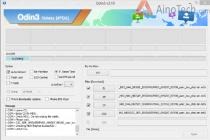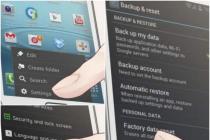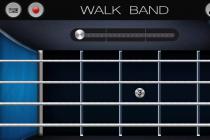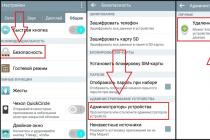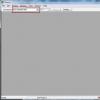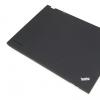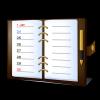Lenovo T series laptops are located in the middle segment of the ThinkPad family. The devices in this series are characterized by a strong combination of price, portability and performance. The 14-inch Lenovo T400 laptop is less bulky than the Lenovo SL laptop or R-series devices, and is much less expensive than the Lenovo X portable devices or the heavy-duty W-series devices. The device is priced at $ 1,549. At the same time, this device combines top-notch features such as long battery life, switchable graphics and excellent ergonomics. In other words, the device has everything you can expect from a ThinkPad.
Lenovo T400 laptop: design overview
While HP and Dell have already provided their line of business notebooks with more modern designs, the Lenovo T400 offers no new features to the classic ThinkPad look. The laptop's keyboard and chassis are finished in classic black with a bright red Track Point joystick and blue accents on select keys, including the ThinkVantage button. This button launches the Lenovo software utility and the enter button. Below the screen is a row of green status lights. Unlike the SL series, the Lenovo T400 uses simple metal hinges instead of sleek black hinges. The laptop cover is not made of glossy plastic. It does not have a luminous logo like the SL series devices. Like the SamsungX 460 devices, the Lenovo T400 is 33mm thick at its thickest. The extended 9-cell battery creates a significant bulge at the back of the device. In addition, this increases the total weight of the device to 2.54 kg. The laptop fits comfortably on your lap and does not tip over when working. The back of the device is much heavier than the front.
The Lenovo T400 laptop traditionally comes with all the ports a professional might need. There is only one exception to this. On the right side there is an optical drive and one USB port. On the left side there is an Express card / 54 slot, an Ethernet port, a modem connector and two USB ports. On the front panel there is a Fire Wire connector and a connector, a microphone input, a headphone output. There is a Kensington lock on the back panel. For added security, the system even comes with an optional fingerprint reader. The basic configuration does not include a memory card reader, which is essential today. However, it is available as an option for an additional $ 10 fee. Also, many users would like to have HDMI and Display Port ports in the device. But it's worth noting that these connectors are not vital.
Lenovo T400: keyboard, touchpad and Track Point
The Lenovo T400 is a laptop with exactly the same keyboard as other ThinkPads. Keyboard keys have a predictable layout and strong feedback. However, if we consider it next to other devices in the line, it can be noted that Lenovo T400 has less responsive keys. In addition, the Lenovo T400's keyboard flexes noticeably. Users also note the use of a weaker base plate than the ThinkPad T61 and the difference in internal design. A miniature Track Point joystick is located between the "P" and "P" keys. Most users prefer the touchpad, but many have appreciated the accuracy of this pointing device. Users who type blindly were delighted to be able to move around the screen without taking their hands off the center row keys. Users who dislike the Track Point joystick can ignore it entirely and use the precision touchpad below the space bar for navigation.
Lenovo T400: heating temperature
Lenovo T400, like other ThinkPad notebooks, stays cool when in use. After 15 minutes of surfing the Internet, the heating temperature between the G and H keys did not exceed 29 degrees. The touch panel heated up to 28 degrees. The back of the case warmed up to an average of 29 degrees. Any temperature below 32 degrees, according to experts, can be considered cool.
Lenovo T400: display
The Lenovo T400 is equipped with a 14.1-inch LED-backlit screen. The screen reproduces crisp images and vivid colors during normal notebook use and video playback. Color quality remains stable at angles up to 45 degrees. This is enough for three adults to simultaneously sit at the screen and watch a movie. The Lenovo T400 laptop is available with a resolution of 1440 × 900 or 1280 × 800 pixels. Users recommend choosing the option with the best display performance. On a 14.1-inch screen, the resolution of 1440x900 dots provides enough screen space to comfortably browse all content on the Internet or long documents without straining your eyes. A 1.3 megapixel webcam will be more than enough for video conferencing. However, this will obviously be too little to create high-quality photographs. Videos and shots taken in low light conditions will be quite bright, clear, but pixelated. Skype video chat is pretty smooth. The device sounds surprisingly good. The built-in speakers produce clear, loud, albeit slightly metallic sound. This applies to both watching videos and playing music. As users note, when listening to rock, jazz and dance-pop, they did not experience distortion even at maximum volume. Still, the results obtained are quite far from Hi-Fi systems. Music lovers will most likely need external speakers or headphones.
Lenovo T400: switchable graphics
Lenovo offers the T400 model with two different graphics options: an integrated Intel GMA 4500 M HD chip, or a switchable graphics solution that allows users to choose between an energy efficient chip from Intel and the more powerful ATIMobility Radeon HD 3470 graphics card without rebooting.
Lenovo T400: performance
Intel Core 2 Duo, 2GB DDR3 RAM, and Centrino 2 chipset deliver strong performance benchmarks for the Lenovo T400 laptop. In high performance mode, the switchable graphics performance in the PC Mark Vantage benchmark scores an impressive 3576 points. This is 700 points higher than the average for light and thin computing systems. This is better than the Fujitsu Life Book S6520 (3383), Dell Latitude E6400 (3025) and Lenovo's SL 400 (3411). The Elite Book 6930P, which scored higher (3749), has a slower 2.4GHz processor, an ATI Mobility RadeonHD 3450 graphics card, and has a lower resolution of just 1280 x 800 pixels. In their reviews, users positively evaluate both modes of operation of the Lenovo T400 laptop. The laptop can simultaneously receive a Skype video call, broadcast HD video streaming, and edit a document in Microsoft Word without much lag, using both the low-cost and the integrated GPU. Loading takes 1 minute 5 seconds. This is 1 second slower than average for this class of notebooks. However, users would still like to reduce the start-up time at least to the level of the Dell Latitude E6400 laptop.
Lenovo T400: Graphics Performance
The Lenovo T400 in High Performance mode scored 2,557 points in the 3DMark06 benchmark. That's 1200 above average and beats the Samsung X460 and SL400. When using an energy-saving processor, the test results drop to 753 points, which is 600 below the average. LenovoT400 owners do not recommend using the laptop as a gaming machine. The FEAR test in high performance mode shows 35 fps at 1025 × 769 and 24 fps at 1440 × 900 pixels. Energy-saving graphics allow you to get only 15 and 6 fps, respectively. As a business system, the Lenovo T400 offers decent multimedia performance. Watching DVDs in both discrete and integrated graphics is quite enjoyable. Darkened scenes are reproduced with less distortion and noise. The plots are quite colorful.
Lenovo T400: hard drive performance
The Lenovo T400 laptop is available with HDD and SSD options. Based on user feedback, 160GB 7200 RPM Hitachi hard drives represent the weakest link in overall laptop performance. The drive completed the test copying of 4.97 GB in 5 minutes 9 seconds. This corresponds to 16.5 MB / s. It should be noted that this value is average for the models in this category. Although the score is higher than the HP Elite Book 6930p, Lenovo SL400 or Futjitsu Life Book S6520 notebooks, the Dell Latitude E6400 runs at 18.5MB / s. System configuration with a larger drive can improve performance. The same Lenovo SL300 laptop with a 250GB Hitachi hard drive is well ahead of the SL400. For those who can afford to pay extra for faster performance, users are advised to purchase solid state drives.
Lenovo T400: Wireless Performance
Intel WiFi Link 5100 provides high speed data transfer rates for this notebook class. On average, it is 20.7 Mbps at a distance of 5 meters and 16.3 Mbps at a distance of 15 meters. You can also optionally equip the Lenovo T400 laptop with integrated mobile broadband cards from cellular operators.
Lenovo T400: battery life
In a battery test of continuous web surfing over Wi-Fi in high performance mode, the battery life of the Lenovo T400 laptop was 5 hours 19 minutes. This value is quite comparable with the data obtained for Lenovo SL 400 laptops (5 hours 20 minutes) and Dell Latitude E6400 (5 hours 17 minutes). Lenovo T400 in power saving mode can last all 6 hours and 26 minutes. This is significantly higher than the average for the entire category of devices - 4 hours 28 minutes.
However, it should be borne in mind that testing was carried out with a nine-cell battery of accumulators. Six- and four-cell devices exhibit significantly lower battery life.
Lenovo T400: bundled software
Like many other ThinkPad notebooks, the Lenovo T400 is software-free. The system comes with Lenovo Care utilities, including Battery Management, Password Management, and System Restore. Also included are drive and driver protection tools. If upgrading to a new operating system, the user will need to update the Lenovo T400 notebook power management software. You can get drivers and new software from Lenovo.com. However, it should be borne in mind that the manufacturer does not provide drivers for those devices that have not been tested with the Windows 10 operating system.
Conclusion
Benefits of the Lenovo T400 include dual graphics hardware and a long nine-cell battery life. The disadvantages of the system include an outdated design, mediocre hard drive performance, no memory card slot in the standard configuration, and a clumsy appearance when using an extended battery.
- Built-in numeric keypad and integrated UltraNav dual-pointing system with wide touchpad below the keyboard, click zones, label scroll areas, multi-touch; and TrackPoint and customizable touchpad for maximum pointing flexibility.
- ThinkVantage button, individual speaker volume up, down and mute buttons, microphone mute button
- The keyboard has an Fn key, which is a special key located in the lower left corner. The Fn key allows the user to instantly activate the following operating functions by pressing the Fn key and the function key designated:
- Standby / Suspend / Sleep
- Switching between display modes of the device
- multimedia
- Fingerprint reader built into the stand for the rest of your ThinkPad laptop to prevent unauthorized access to your laptop and data
- Waterproof
- ThinkLight keyboard light illuminates the keyboard to improve visibility in low light conditions
- PC3-8500 Non-Parity Technology (NP) Double Data Rate Three (DDR3)
- Two SO-DIMM slots
- The use of 1067 MHz SO DIMMs is recommended for this system.
- 1 GB, 2GB, or 4GB memory
- Supports up to 8GB maximum memory
- 2GB, 4GB Intel Turbo Memory (on select models)
Note: Only 64-bit operating systems support more than 3GB of system memory (RAM).
- All systems come with an UltraNav dual pointing system, featuring a TrackPoint and a customizable touchpad for maximum flexibility when pointing is part of the keyboard. TrackPoint features Press-to-Select, Internet scrolling and magnifying glass for precise and easy control.
Connection
extension
Operating environment
For systems with a 358.1 mm (14.1-inch) TFT display:
Platform:
- Width: 337mm (13.3 in)
- Depth: 241mm (9.5 in)
- Height: 21.1 to 25.9 mm (0.83 to 1.02 in)
- System weight adjusted: Starting at 1.77 kg (3.9 lb)
Environment:
- Maximum altitude naturally aspirated: 3048 m (10,000 ft)
- Temperature
- Up to 2,438 m (8,000 ft)
- Operating: 5.0 ° C to 35.0 ° C (41 ° F to 95 ° F)
- Non-operating: 5.0 ° C to 43.0 ° C (41 ° F to 109 ° F)
- Above 2,438 m (8,000 ft)
- Maximum operating temperature under reduced pressure: 31.3 ° C (88 ° F)
- Up to 2,438 m (8,000 ft)
- Relative humidity:
- Operating: 8% to 80%
Downtime: 5% to 95%
Note: When charging the battery, the temperature must be at least 10 ° C (50 ° F).
Thermal power
- 65 W (222 BTU / hr) maximum or maximum 90 W (307 BTU / hr) (depending on model)
Accessories:
Note: All weights and dimensions are approximate.
power
- The battery pack is the computer's internal power source when an AC adapter is not available. The battery is rechargeable and charged using the AC adapter with the system.
- You can determine how much battery power remains by using the ThinkPad Fuel Gauge Utility. This shows the percentage of charge remaining, whether there are one or two batteries in the system.
- Another optional lithium-ion battery, the Ultrabay Li-Polymer battery, fits into the Ultrabay Slim so that two batteries can be installed to extend battery life.
- A six-cell rechargeable lithium-ion battery is supplied with the system.
- An optional three cell Ultrabay Li-polymer II battery for extended battery life is available.
- Li-ion battery: 6 cell, 3.9 Ah, 312 g (0.69 lb)
- Battery Life:
- 6 cells: up to 6.5 h;
- 6-cell battery plus Ultrabay: up to 11 h
- Rated voltage: 10.8V DC
- Capacity: 4.0 AH
Notes (edit):
- (* 1) Battery life (and recharge times) will vary based on many factors including screen brightness, applications, features, power management, battery conditioning, and other customer preferences.
Security
- Password Manager (HPM) Hardware
- Intel Anti-theft (AT)
- Security chip
- The fingerprint reader, on some models, offers users a convenient solution, authentication at system startup and log on to Windows with the touch of a finger.
- A locking device in the security slot provides physical security.
- ThinkPad Embedded Security Subsystem provides authentication and encryption of data transmission.
- At power on, a password (POP) protects the system from unauthorized use. If POP is installed, you will be prompted for a password:
- Every time the system is turned on
- When the system returns to normal operation from standby
- Supervisor Password is more secure than POP. Supervisor Password protects system functions from unauthorized users and also protects hardware configuration from unauthorized changes. Supervisor Password prompt appears:
- When the BIOS setup screen is available.
- Hard Disk Password (HDP) protects the data on your hard disk from unauthorized access. Once HDP is installed, the data on the hard disk cannot be accessed without the correct HDP. Since HDP is stored on the hard drive, data remains protected even if the hard drive is removed to another system. You will be prompted to enter the HDP password:
- Every time the system is turned on.
The ultra-thin Lenovo ThinkPad T400s mobile laptop is a sophisticated computer that includes the latest technology for those who are primarily engaged in business and, in general, who counts every minute. This laptop will be an indispensable purchase for all users who lead an active lifestyle.
The excellent Lenovo T400s is very compact, as its thickness is just over two centimeters with an available weight of 1.8 kg.
The computer runs on a lithium-ion battery. The laptop can work for about 5 hours without recharging. A lot has been thought out in this model, including the ability to connect a second battery in case of a shortage of operating time without recharging. Thus, with an additional battery, the laptop will work up to 8.5 hours.
Design
The design of the laptop is striking in style. Classics are ideally combined with unsurpassed strength. The traditional black coloring of the computer contrasts with the scattering of red elements. In appearance, the shapes of a computer are the simplest.The lower part is made of magnesium alloy, the upper part is quite sturdy. From the outside, you can feel the special soft touch coating. The lid of the computer is velvety and pleasant to the touch. By the way, thanks to this, it will not be so easy to let go of the laptop. The ThinkPad T400s is built around the Roll Cage, which is made up of carbon fiber used in aircraft manufacturing.

What about interior design? Inside - the usual practical plastic. Its matte surface will not "show" all kinds of fingerprints, and dust will not collect too often.
Display
A beautiful 14 ”WXGA TFT screen with a matte finish allows you to work without noticing glare. With an aspect ratio of 16x9 and a resolution of 1440x900, it is optimal to watch movies.
The touch screen of a laptop is capable of recognizing various touches, and at several points at once.
The built-in 2MP webcam allows you to get high quality images even in low light conditions.
Keyboard and touchpad

The Lenovo ThinkPad T400s has an excellent, ergonomic, spill-resistant keyboard. In addition, if moisture does get on the keyboard unit, it will be removed by a special fluid drain system. The keyboard makers of the ThinkPad T400s have thought out the smallest detail. First, a bright LED illuminates the keyboard. Secondly, it consists of 89 full-size buttons, curved to the shape of the fingers. Thirdly, the distance between all buttons is reduced, and the Delete and Escape keys are increased in size. Another feature is the added key, thanks to which you can mute the microphone.
The touchpad on the work surface is of standard dimensions, although the sensitive area itself is small. The touch field is pleasant to the touch, it is very convenient to work with it, because the texture allows you to use the touchpad without looking. The touch panel is supported by the multi-touch function - Multitouch.
Additional convenience is provided by another TrackPoint pointing stick with two standard buttons and one middle key for scrolling in different directions.
Processor and packaging
The laptop runs pre-installed with the Windows 7 operating system. Intel-based dual-core processor Core 2 Duo SP9400 runs at a good clock speed of 2.4 GHz and is equipped with six megabytes of L2 cache. In this model, it is possible to expand the capabilities of the computer by installing a more powerful processor.Feature Lenovo ThinkPad T400s is the ability to maximize its integration, thanks to the ConstantConnect and Protect technology.
As for memory, this model stores information on a hard disk with a capacity of up to 250 GB. DDR3 RAM has a capacity of up to 2 GB. The compact hard drive operates at 5400 rpm, but it cannot be called fast. Additionally, it is worth noting the protection of information on the hard disk provided by the manufacturers in the event of a laptop falling.
The graphics capabilities of the laptop are represented by the integrated Intel GMA4500MHD video adapter.

Ports, card reader, optical drive.
Despite the thickness of 21 mm, the ThinkPad T400s has an optical drive. Removable DVD-RW SuperMulti writer makes it possible to work with a variety of discs, including dual layer ones. The optical drive can write discs at 8x speed.Wireless communication is widely used in Lenovo ThinkPad T400s. There are not only traditional Wi-Fi adapter and Bluetooth controller, which allow transmitting signals over a distance between various devices, but also WiMAX, WWAN, UWB.
The placement of ports in the ThinkPad T400s is not convenient, since for the most part they are located on the back. Ports include an Express Card slot, Display Port, VGA and built-in USB / eSATA. With VGA and Display Port, you can connect two monitors.
Unfortunately, the notebook does not have a memory card reader.
It should be noted that if your computer is off, you can recharge various devices through a special USB port: cameras, MP3 players.
Another possibility of simplifying the switching on of the laptop is realized through the use of a special biometric scanner. Swipe once and if the sensor recognizes the user, the computer will turn on.
Widget from SocialMart
Conclusion
The Lenovo ThinkPad T400s laptop will become an indispensable assistant not only for mid-level businessmen, but also for leaders of large companies. A small and at the same time productive computer in its parameters is suitable for both men and women who are often on the move and travel.Thin and light CULV notebooks were the revelation of the past 2009. And no wonder - they are extremely compact, capable of living for a very long time without an outlet, and they look spectacular, in the end. In addition, they are quite cheap and have become a real salvation for many in a crisis year. Mobility is suddenly really affordable. And it became foolish to pay for it that crazy money that all manufacturers joyfully took from buyers for many years. At least, the compact size and low weight alone cannot be sold so well today, you need to add something really valuable to them in order to get the marketer's dream - the notorious Unique Selling Proposition. Not all manufacturers were able to adapt to the new order. But Lenovo has something to offer the buyer - sophisticated ergonomics, increased resistance to external influences, performance and, finally, image. All of the above plus maximum compactness - this is the ThinkPad T400s. Everything looks tempting on paper. What is it really?
⇡ Specifications
| Lenovo ThinkPad T400s | |
|---|---|
| CPU | Intel Core 2 Duo SP9400: 2.4 GHz; 6 MB L2; FSB 1066 MHz; two computing cores |
| Chipset | Intel GS45 |
| Graphics controller | Chipset-integrated, Intel GMA 4500MHD |
| Screen | 14.1 inches, 1440x900, matte finish, LED backlight |
| RAM | 2 GB, DDR3-1066 |
| HDD | 250 GB, SATA II, 5400 rpm, 1.8 '' form factor (Toshiba MK2529GSG) Accelerometer |
| Optical drive | DVD-RW SuperMulti (Sony Optiarc AD-7910S), removable |
| Memory card slot | No |
| Interfaces | 3x USB 2.0 1x eSATA (shared with USB) 1x ExpressCard / 34 1x VGA (D-Sub) 1x DisplayPort 1x RJ-45 1x headphone output (mini-jack 3.5 mm) 1x docking connector |
| Wi-Fi | 802.11b / g / n (Realtek 8191SE) |
| Bluetooth | 2.1 + EDR |
| Network adapter | 10/100/1000 Mbps (Intel 82567LM) |
| Sound | HDA; two speakers, two microphones |
| Battery | Li-Ion, 43.3 Wh (3900 mAh, 11.1 V) Possibility of connecting an additional battery |
| Other | Spill-resistant keyboard with external backlight, fingerprint sensor, two manipulators (Touchpad and Trackpoint) |
| Size, mm | 337x241x21 |
| Weight, kg | 1,8 |
| Operating system | Windows 7 Home Premium (32 bit) |
| Official manufacturer's warranty | 12 months (can be expanded to 36) |
| Approximate price, rub. | From 56 000 |
The laptop is built on the good old Intel Centrino 2 platform, also known as Montevina. The components of increased compactness are used - the "north bridge" of the reduced size GS45, as in the CULV platform, and the SP series processor. But the performance is quite "adult" - the processor is dual-core, operates at very impressive frequencies and is equipped with a second-level cache memory of 6 MB.
Despite the rather serious stuffing, the weight of the laptop is very small - ThinkPad T400s weighs about the same as CULV-notebooks with the same screen size. Or, in other words, a little less than the average weight of "trinashki" on high-performance processors. This combination is truly impressive.
The ThinkPad T400s uses a compact hard drive with 1.8-inch platters. The spindle rotation speed is 5400 rpm, which is very much even for hard drives of this form factor.
Of course, the disk subsystem is equipped with an accelerometer that monitors the position of the laptop in space and parks the drive heads in the event of a potential impact or fall. This is a typical component of ThinkPad notebooks, and it would be strange if it was not included in the flagship model of this family.
⇡ Design and ergonomics
The ThinkPad T400s has a classic design. The laptop looks exactly the same as all of its brothers in the family, including several previous generations of ThinkPads - a radical black color, a scattering of small bright red elements, deliberately rough and simple shapes. In general, the style is one hundred percent recognizable. The only thing that makes the T400s different from its siblings is its size. The case is not super thin like the MacBook Air or Sony VAIO X-series, but its thickness is impressive. The bottom of the notebook is made of magnesium alloy, the lid is made of a combination of carbon and fiberglass. It is slightly more flexible than the lids of regular ThinkPads. However, its durability does not cause much concern, in contrast to the "millimeter" covers of many Japanese notebooks. The outer side of the lid is provided with a velvety soft touch coating. The material looks good, is pleasant to the touch and prevents the laptop from slipping out of your fingers too easily. True, for these qualities you have to pay with increased soiling. The interior of the finish is ordinary matte plastic. Not particularly aesthetic, but damn practical - durable and absolutely not prone to collecting dirt, dust and fingerprints. The keyboard is just gorgeous. Large keys of a classic design, with a bend that follows the shape of the finger. Convenient layout and excellent mechanical properties. You can only find fault with the "proprietary" incorrect position of the Fn button. All ThinkPad notebook keyboards are spill-resistant. Generally speaking, this is far from an exclusive feature, and spill-resistant keyboards are found in laptops of many Lenovo competitors. But what no one else has is a system for draining liquid that has got into the keyboard unit. The backing of the keyboard has curved edges and is a kind of pallet. There are drains in several places on the edge of the pallet and through the drainage holes that permeate the entire case, moisture is discharged to the bottom of the laptop. In previous generations of ThinkPad notebooks, these holes were circular. However, starting with the ThinkPad X301, their shape has changed - now the drains are rectangular in cross-section. Lenovo claims that the new design of the drain holes allows for more efficient drainage of moisture by reducing wetting overhead. The keyboard is backlit - a small but very bright LED is mounted in the upper crossbar of the display frame, the light from which is directed downward and slightly forward. Surprisingly, the modest-sized LED illuminates the keyboard fairly tolerably - in the dark, the buttons are really visible. Of course, the internal key illumination is more efficient and looks more elegant. But Lenovo believes that an attempt to build diodes into the keys themselves will negatively affect their keys, mechanical qualities. The touchpad isn't exactly cramped. However, the area of its sensitive area is not too large. But a larger panel would not fit - due to the presence of two manipulators at once, there is not much space left on the case. The touch panel has a velvety surface that is pleasant to the touch - a dense mesh of soft touch paint droplets is applied across its entire area. Controversial decision. Still, nothing better than smooth (but not glossy, but slightly rough) surfaces for touch panels has not been invented. And to see such dubious experiments in the ultra-conservative ThinkPad is a little strange. The second manipulator, the Trackpoint mini-joystick, is a thing, although not for an amateur, but still has its fans. It is definitely more convenient when working with a laptop under the weight. But some people prefer it to a normal mouse even for desktop use. In this case, it should be borne in mind that the mini-joystick lacks a click function - light tapping on the top does not lead to anything, so you will have to use the buttons. In addition to the standard two buttons, there is also a third, middle one. It is designed for scrolling - pressing and holding it turns the TrackPoint into a scroller, and scrolling works in all directions - both vertically and horizontally. The most convenient function. The fingerprint sensor found in the ThinkPad T400s looks a bit unusual. Typically these sensors are a narrow, gold-colored metal strip. And in ThinkPad T400s, the sensor is radically black - apparently, so that it does not stand out from the general color gamut in which the laptop is made. This is a little confusing at first, it seems that the sensor has a protective cap and needs to be removed before use. But no - this is his natural color. On the sides of the sensor are two miniature LEDs - green and red. What are they needed for? The fact is that the sensor can be used instead of the laptop power button. When the computer is turned off, it is enough to slide your finger along the sensitive strip - and, if the finger is "correct", the sensor will blink a green diode a couple of times. If the finger is not recognized by the security system, then the red light will blink. In the first case, the laptop turns on immediately. And, importantly, there is no need to swipe or enter a password from the keyboard at the entrance to Windows a second time, authorization will happen automatically. The communication ports in the Lenovo ThinkPad T400s are rather strange. On the one hand, there are not so few ports - there are as many as three USB connectors, eSATA, analog and digital (DisplayPort) outputs to an external monitor, even for an ExpressCard slot there was a place, albeit for a miniature 34 mm one. There is even an optical drive! This is what you would not expect from such a lightweight laptop. But the placement of the connectors is not very good, almost all of them "moved" to the rear side of the case. The user has only one USB port, a combo audio jack and an ExpressCard slot at hand, and to connect everything else, you will have to reach for the laptop lid. And for some reason, the Lenovo ThinkPad T400s does not have a memory card reader, which is somehow strange for a laptop, which in all other respects is a real boon for a traveling photographer. As befits a corporate laptop, the ThinkPad T400s has a docking station that expands the range of connectors and makes the transition from stationary to mobile faster and more convenient. Not forgotten, and another feature typical of business notebooks - the modular compartment. The optical drive can be removed quickly and conveniently - it is not fixed with screws, but with latches. Instead of an optical drive, you can install an additional battery, or you can use a dongle, which will reduce the weight of the laptop by another 150 grams. Unfortunately, neither one nor the other is available in the standard configuration of the ThinkPad T400s. The bottom has a single compartment containing replaceable components. It contains a pair of memory expansion slots and two Mini Card slots. In our case, only one of them was occupied, half the length - a wireless adapter was installed in it. In the second, full-size connector, a 3G module can be installed - all the necessary wiring is available, as well as the SIM card slot located under the battery. Pay attention to the legs of the laptop. Their shape is not accidental, it was deliberately made so intricate. Everything so that the legs damp better. According to Lenovo employees, they were inspired by cat paws to create these legs. A painless fall from a great height is a true feline feature. Such a useful feature will not hurt laptops either, so the ThinkPad engineers decided to borrow the "design" from nature.Often, the new is the well-forgotten old. But in the case of new models from IBM / Lenovo it would be more correct to say - "classic". The most correct forms, a minimum of design delights, everything is strict, but stylish and tasteful. This is exactly what a laptop should be, the main buyer of which is a corporate consumer. Externally, the new generation of the T series is no different from the old - the differences are only in the digital index and filling. Both the ThinkPad T400 and T500 notebooks discussed in this article are built on the new mobile platform Intel Centrino 2, both are equipped with Intel Core 2 Duo P8600 processors and 2 GB of RAM. But the older ThinkPad T500 has a video subsystem based on AMD RADEON HD3650, and the younger ThinkPad T400 - on the HD3470. In addition, the matrices differ - the 15-inch model has a screen resolution of 1680x1050 pixels, and the 14-inch model has 1440x900 pixels.

| OS | Windows XP Professional |
| CPU | |
| Chipset | Intel GM45 + ICH9-M |
| Video | AMD Mobility Radeon HD3470, 256 MB |
| Sound | Conexant Cx20561 |
| Matrix type | 14,1, 1440x900, Lenovo (Samsung) LTN141WD-L05 |
| RAM | 2 GB (2x PC3-8500 DDR3) |
| HDD | 250 GB (Hitachi HTS542525K9SA00) |
| Optical drive | LG HL-DT-ST DVDRAM GSA-U20N |
| Interfaces | 3x USB 2.0 1x VGA 1x Firewire (IEEE 1394a) 1x RJ-45 1x RJ-11 1x memory card slot 1x ExpressCard / 54 1x headphone jack 1x microphone jack |
| Wireless interfaces | Intel WiFi Link 5300 |
| Network adapter | |
| Additionally | Webcam, 1.3 megapixel |
| Battery | Lithium 6-section, 56 W * h (5200 mAh) |
| Dimensions, mm | 335,5x238x34,9 |
| Weight, kg | 2,5 |
| Cost, rub. | ~ 50,000 - 70,000 RUB |

The delivery set includes the following items:
- Charger;
- manipulator overlays (trackpoint);
- complete instruction manual;
- initial installation instructions;
- safety and warranty manual;
- brochure with a list of optional accessories.
The ThinkPad T400 still has the same classic look as most previous models, including those directly from IBM laptops. When folded, it is a strict parallelepiped with barely smoothed corners. The display lid is made of the material familiar to Lenovo laptops - matte plastic containing metal chips.

The material looks great, and besides, it is very practical - minor scratches that pursue "glossy" notebooks are not scary to it, as well as fingerprints. Under pressure on the lid, it bends quite a bit, but until it touches the fragile matrix, the rigid Roll Cage frame made of magnesium alloys prevents it from bending. The work area panels are made of thick black plastic with a rough surface, and the bottom is made of slightly thinner black plastic with a matte surface.

The case flaps are connected by small but powerful metal hinges integrated into the laptop frame. The lid is held in the folded state by two hooks, and the latch of the lock is located at the right edge of the front end of the lid. The rubber shock absorbers on the lid are very tiny, and when the laptop is folded, they do not cope with their main task at all, and, despite the presence of two hooks, there is a gap of about 0.5 mm between the flaps. There is also a slight backlash in the battery mount. Otherwise, the build quality turned out to be very good, although the overall impression was still slightly spoiled by the backlash of the lid.

The front edge carries an IEEE-1394 port, a wireless switch, a pair of standard audio jacks, and the aforementioned lock latch.

At the back, a large part is occupied by a battery, to the left of which there is a slot for installing a security lock, and to the right is an external power connector and a ventilation grill.

The left side is the busiest - a ventilation grill, a VGA port, communication ports RJ-11 and RJ-45, a pair of vertically arranged USB ports, a slot for installing ExpressCard / 54 expansion cards and a PCMCIA port, in place of which, as in our case, can be installed memory card reader. We noted a few shortcomings in the layout of the left panel. First, the surface is too busy. Secondly, vertically located USB ports are too close to each other, moreover, with such an arrangement of the USB port, the likelihood of damage to the installed connector is much higher than with horizontal placement.

The right panel contains the hard drive bay cover, one vertical USB port, and a removable optical drive that can be replaced with an optional battery or blank cover. The bottom of the laptop is flat and lined with many vents, but they are small. A docking connector is installed in the central part of the bottom.

The work area is not much different from most T-series notebooks. One drawback should be noted right away - under pressure above the keyboard, in the area of the off button, the casing panel noticeably bends, which is very strange, given the general "knock-down" and rigidity of the casing. The keyboard is full-sized, with a width of 18.5 mm alphabet keys. The key travel is soft, with a clear indication of the moment of actuation, but, unfortunately, the keys are quite noisy. With strong pressure on the keys, the base of the keyboard wobbles noticeably, which is especially noticeable on the right side.

Under the keyboard there are three manipulator keys, the "trackpoint" is located between the keys in the center of the keyboard. The touch panel has a size of 70x38 mm and is equipped with horizontal and vertical scrolling areas. The keys of both manipulators have a fairly long stroke, but all keys are quiet.

Under the keyboard, in the area of the arrow keys, there is a mandatory element for the corporate segment of laptops - a fingerprint scanner. Above the keyboard is a power off button, as well as volume control keys and a ThinkVantage Productivity Center branded menu button. In the corners, a pair of built-in speakers are hidden under a decorative grille.
Ten system status indicator lights are embedded in the bottom of the display lid. When the cover is closed, the indicators for the network, battery status and standby mode are available. Built into the top edge of the display lid is a webcam and a tiny keyboard backlight.
Display
The laptop has a 14.1-inch widescreen display with a matte surface and a resolution of 1440x900 pixels. In the test packages, the matrix is referred to as Lenovo, but in fact nothing else is installed but a Samsung product - the LTN141WD-L05 model, more detailed characteristics of which can be found on the manufacturer's website. The display is quite contrasting and bright, it does not turn into a mirror under back or side lighting, because it has a matte surface rather than a glossy one. The backlight power is enough to work in any conditions. But the color reproduction and viewing angles (especially horizontal) leave much to be desired - at the slightest deviation from the direct viewing angle, the colors fade and become inverted, so before work you will have to adjust the angle of inclination of the matrix.
| OS | Windows XP Professional |
| CPU | Intel Core 2 Duo P8600 (2.4 GHz) |
| Chipset | Intel GM45 + ICH9-M |
| Video | AMD Mobility Radeon HD3650, 256 MB |
| Sound | Conexant Cx20561 |
| Matrix type | 15,4, 1680х1050, (LG-Philips LP154WE2) |
| RAM | 2 GB (2x PC3-8500 DDR3) |
| HDD | 160 GB (Fujitsu MHZ2160BH G1) |
| Optical drive | Matsushita DVD-RAM UJ862A |
| Interfaces | 3x USB 2.0 1x VGA 1x e-SATA 1x Firewire (IEEE 1394a) 1x RJ-45 1x RJ-11 1x memory card slot 1x ExpressCard / 54 1x PCMCIA 1x headphone jack 1x microphone jack |
| Wireless interfaces | Intel WiFi Link 5300 |
| Network adapter | Intel 82567LM Gigabit Network Connection |
| Additionally | Webcam, 1.3 megapixel |
| Battery | Lithium 6-section, 56 W * h (5200 mAh) |
| Dimensions, mm | 357.5x255x33.5 |
| Weight, kg | 2,7 |
| Cost, rub. | ~50 000 |

Appearance and ease of use

Models T500 and T400 are similar in appearance, like twin brothers, and if you do not put them side by side, it is difficult to understand who is who. The same materials and the same Roll Cage magnesium alloy frame are used. Even the backlash between the flaps at the front edge is the same.

But, fortunately, the T500 has no battery lock play, it sits like a glove. The only difference is the location of connectors and interfaces at the ends of the device.

On the front, a memory card slot has been added to the IEEE-1394 port, wireless switch, a pair of standard audio jacks, and a lock latch.

The back surface is absolutely flat, and the battery of the same capacity does not protrude beyond the boundaries of the case, as in the T400. Therefore, the body looks neater and more stylish. To the left of the battery there is a security lock eyelet, and to the right is an external power supply connector and a ventilation grill.

The right panel looks completely empty, but its entire surface is used by various elements: the cover of the hard drive compartment, the optical drive tray, which, like in the case of the T400, can be easily removed at the press of a button, and the RJ-11 connector.

The left panel contains a ventilation grill, a VGA port, e-SATA, RJ-45 connectors, three vertical USB connectors and two slots for expansion cards - ExpressCard and PCMCIA. A more unfortunate location of USB connectors than Lenovo ThinkPad T500 still needs to be looked for - vertical placement is already a disadvantage, but in addition, only three connectors are set so close that when working with several USB devices, you constantly have to use adapters or USB-Hub ...
On the bottom, only the port replicator connector is available to the user. The memory modules, as in the case of the T400, are accessible only after dismantling the panel under the keyboard, however, this panel can be easily removed. The working surface of the T500 does not differ at all from the T400, so there is no point in describing it in detail. It is worth noting only that the body panel above the keyboard under pressure bends much less, and the keyboard does not walk at all.
Display
The laptop has a 15.4-inch widescreen display with a matte surface and a resolution of 1680x1050 pixels. The matrix is produced by the LG-Philips tandem, model LP154WE2, the detailed characteristics of which can be found on the manufacturer's website. The matrix has pleased in all respects. The first thing that catches your eye is the large viewing angles in both planes. Contrast and color rendition are also high, and the matte surface of the matrix allows you to work comfortably in the presence of a back or side source of bright light. You can work outdoors on a sunny day, but the brightness is still a little lacking. When displaying a uniform dark field at the top and bottom edges, a slight backlight is noticeable, but it is so small that it is completely invisible during everyday work.
Sound subsystem
The sound subsystem of both laptops is based on the integrated Conexant Cx20561 codec. It is very difficult to find any information about this codec on the manufacturer's website, but from scraps of scattered information, we can conclude that this codec combines the functions of a modem and an audio codec. The ThinkPad T400 and T500 models are equipped with the same speakers, they are also placed almost the same, so there is practically no difference in sound - a narrow frequency range, the sound is empty, but at the same time it is well detailed and loud, and when you set the maximum volume, it does not "choke" or wheezes. The headphones sound pretty good on both laptops, which was later confirmed by tests. The audio section was tested using the popular RightMark Audio Analyzer 6.0.6 test suite. (hereinafter RMAA) using the Creative E-MU 0202 USB audio interface. Equalizer settings are default. Overall rating is very good!
Wireless interfaces
In terms of communications, and especially wireless communications, laptops are exactly the same. Both have a pair of wireless interfaces - Bluetooth v2.0 + EDR and an Intel WiFi Link 5300 Wi-Fi module. The latter is mandatory for the Centrino2 platform, but an option such as the ThinkPad 11b / g Wi-Fi module is also available in the model configurator. Wireless LAN Mini PCI Express Adapter III, which is $ 40 cheaper than the laptop we tested. Also, both laptops can have a 3G modem (the card slot is located under the battery) and a WiMAX module combined with a wireless network adapter. However, the samples provided for testing were not equipped with them. It is worth noting that both technologies are increasingly spreading in large cities of the CIS, and the hour is not far off when slow EDGE will send the last bit of information, giving way to faster methods of data transfer.

Setting up network connections is possible both using standard OS tools, and using additional software supplied with a laptop, which, by the way, is from Lenovo, and in the past also from IBM, very convenient and functional.
Noise level and thermal conditions
Both laptops are neither too noisy nor too hot. In idle mode, the T500 model barely noticeably rustles with the fan blades, the noise they create does not exceed 32.9 dB. At large and long-term loads, the noise level rises only up to 34.3 dB, and very rarely and for a short time (for 5-20 seconds) - up to 36.5 dB. The fan speed set is very funny - the sound resembles the growl of a sports motorcycle, somewhere in a couple of kilometers gaining momentum.
With heating, everything is also not bad. The temperature of the air flow discharged by the fan is 51.3 degrees, the temperature of the working surface, depending on the measuring point, varies from 28.4 to 31.3 degrees, and the temperature of the bottom - from 27.2 to 36.0 degrees. The hottest spot is under the processor.
The T400 makes a little more noise - already in idle mode, the noise level is 34.6 dB, at high loads it instantly rises to 36.9 dB, and sometimes reaches 38.5 dB under prolonged loads. The speed of rotation of the impeller in the T400 does not occur smoothly, as in the T500, but sharply, with a pronounced step. But the T400 heats up a little less. The temperature of the "exhaust" is 47.2 degrees, the working surface is 28.1-30.0 and the bottom, depending on the measuring point, heats up to a temperature of 26.7-35.6 degrees.
Performance
Both laptops are based on the Centrino2 platform. In fact, they only have different video cards: the older brother T500 has an HD3650 adapter, while the T400 has an HD3470. The opponent was Samsung R560, also built on the Centrino2 platform, but equipped with an nVIDIA GeForce 9600M GT video card and twice as much RAM.
| Performance | Samsung R560 | ThinkPad T400 | ThinkPad T500 |
| PCMark05 | 4673 | - | - |
| Cpu | 5727 | 6097 | 6100 |
| Memory | 4935 | 5130 | 5146 |
| Graphics | 5384 | 2498 | 4250 |
| HDD | 3871 | 4605 | 4702 |
| System Test |
|||
| HDD XP Startup | 5.9 MB / s | 8.3 MB / s | 8.8 MB / s |
| Physics and 3D | 201.1 FPS | 209.0 FPS | 221.4 FPS |
| 2D Transparebt Windows | 264.3 Windows / s | 258.5 Windows / s | 337.8 Windows / s |
| 3D Pixel Shader | 213.5 FPS | 90.7 FPS | 212.4 FPS |
| Web Page Rendering | 1.9 Pages / s | 2.7 Pages / s | 2.8 Pages / s |
| File Decryption | 62.0 MB / s | 67.3 MB / s | 67.3 MB / s |
| Graphics Memory - 64 lines | 1215.9 FPS | 359.3 FPS | 556.8 FPS |
| HDD - General Usage | 3.9 MB / s | 5.1 MB / s | 4.9 MB / s |
| Audio Compression | 1452.9 KB / s | - | - |
| Video encoding | 523.0 KB / s | - | - |
| Text edit | 127.7 Pages / s | 160.7 Pages / s | 158.5 Pages / s |
| Image Decompression | 30.7 MPixels / s | 31.9 MPixels / s | 32.7 MPixels / s |
| File Compression | 5.2 MB / s | 5.6 MB / s | 5.3 MB / s |
| File Encryption | 31.8 MB / s | 30.8 MB / s | 31.5 MB / s |
| HDD - Virus Scan | 27.4 MB / s | 34.8 MB / s | 28.5 MB / s |
| Memory Latency - Random 16 MB | 9.3 MAccesses / s | 9.1 MAccesses / s | 8.9 MAccesses / s |
| CPU Test |
|||
| File Compression | 9.9 MB / s | 10.8 MB / s | 10.7 MB / s |
| File Decompression | 148.1 MB / s | 160.8 MB / s | 160.5 MB / s |
| File Encryption | 62.0 MB / s | 67.6 MB / s | 67.4 MB / s |
| File Decryption | 61.7 MB / s | 67.3 MB / s | 66.9 MB / s |
| Image Decompression | 31.9 MPixels / s | 34.2 MPixels / s | 34.2 MPixels / s |
| Audio Compression | 3008.3 KB / s | 3258.1 KB / s | 3251.4 KB / s |
| Multithreaded Test 1 |
|||
| File Compression | 9.9 MB / s | 10.3 MB / s | 10.3 MB / s |
| File Encryption | 148.1 MB / s | 62.4 MB / s | 63.4 MB / s |
| Multithreaded Test 2 |
|||
| File Encryption | 74.6 MB / s | 77.5 MB / s | 77.4 MB / s |
| File Decryption | 29.9 MB / s | 32.2 MB / s | 32.4 MB / s |
| Audio Decompression | 1214.9 KB / s | 1240.1 KB / s | 1232.9 KB / s |
| Image Decompression | 15.6 MPixels / s | 16.4 MPixels / s | 16.5 MPixels / s |
Power supply and autonomous operation
Both laptops have lithium batteries with a capacity of 56 Wh. The shape of the batteries is unusual, and in the T400 the battery protrudes noticeably beyond the boundaries of the case, while in the T500 it fits into the overall design.
When tested with the Battery Eater Pro package in the "classic" (maximum load) mode, the T500 lasted 124 minutes, the T400 - 167 minutes. Both models have very good results, especially the T400, and, as practice shows, such results for notebooks based on Centrino2 are not an exception, but rather a rule. Both laptops take quite a long time to charge the batteries - almost three hours, but to 90% of the level, both are charged in about 1 hour and 45 minutes.
The laptop comes with preinstalled software for flexible configuration of energy saving parameters, in which it is possible to configure several schemes and quickly switch between them.




